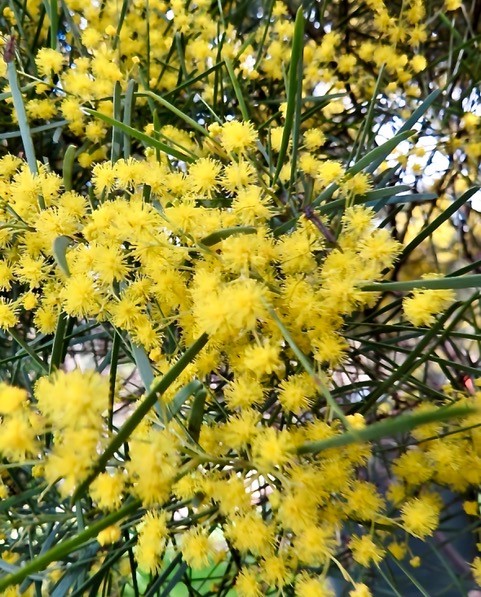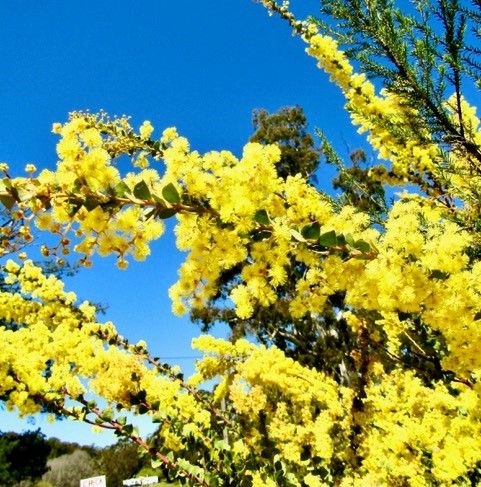August 13th, 2021
Let’s celebrate the return of Wattle Day
Glenlyon has revisited and revitalised the celebration of Wattle Day, once an annual one-day salute to our national floral emblem, the wattle, but this year it is embraced in a week long feast of poetry and art commencing on August 8.
Towards the end of the 19th century there had been several attempts within the colonies to find a national emblem. No doubt Canada’s choice of the maple leaf for theirs had something to do with their choice of the wattle flower and in 1910 we had the first national celebration of Wattle Day.
Early celebrations included the planting of wattle trees on school grounds, school lessons on botany and the wearing of sprigs of wattle, often sold for a charity.
In 1913 the then Prime Minister, Andrew Fisher changed Australia’s Coat of to Arms to include more relevant Australian symbols with a spray of wattle the background feature. In December, the same year, the first wattle blossom stamp was released.
Unfortunately enthusiasm somehow waned, and despite the efforts of ABC’s Ian McNamara’s valiant efforts on his national Sunday morning radio program, Wattle Day appeared to die out. Until now, in Glenlyon!

Wattle trees to celebrate spring
Among the 700 odd species of acacia (wattle) to choose from there must be at least one to satisfy your needs for every spot in your garden. With foliage ranging from spikes, through lacy and fern-like, to long pendulous lush leaves and growing habits from prostrate, ground coverers, through to bushy shrubs, up-right or weeping trees, they have it all covered.
Although early September is when flowering reaches a crescendo, by careful selection you can arrange to have flowers from early winter until early summer.
If that isn’t enough, avid plant breeders have been busy producing hybrid forms including those beautiful soft-leaved weeping forms of acacia cognata and the horizontally growing acacia cultriformis.
I have listed here a reasonable selection of my favourites to suit your possible needs. These may not all be available from your local growers but a quick browse on the internet will no doubt lead you to a specialist native plant supplier. They are mostly capable of success in our climate and in most soil types.

A. acinacea (also known as rotundifolia) H.2m x W. 1.5m – A dense, bushy shrub suitable for use as a windbreak or hedge plant. Its long, arching branches and small, round leaves are smothered in spring by masses of bright golden ball-shaped flowers. Grows best in full sun to partial shade.
A. baileyana (Cootamundra wattle) H.4-6m x W.5m – A favourite small-to-medium tree with attractive silvery-blue, fern-like foliage. In winter its masses of golden, perfumed flowers provide spectacular colour to the garden. Tolerates full sun or shade in any soil from sand to heavy clay.
A. baileyana var. purpurea – A distinctive purple-bronze foliaged variety with all the attributes.
A. boormanii (Snowy River Wattle) H.3-4m x W.2.3m – A large shrub or small tree, often pendulous, ideal as a screen or windbreak, with long, narrow foliage. Its fragrant, golden, ball-like flowers appear from late winter until spring.
A. cultriformis( knife-leaf wattle) – A quick-growing, dense and shapely arching branches. Silvery grey triangular leaves sit closely on the branchlets and are excellent for floral work. The shrub is smothered in golden ball-like flowers in spring. Grows well in well drained light to heavy soil.
A. cultriformis prostrata – An excellent ground cover version with all the attractive features of the upright form.
A. melanoxylon (blackwood) H.20.m x W.10m – A hardy shade tree with long narrow leaves. A shy flowerer with cream, ball-shaped flowers in spring. Prefers a well-watered position with light to-medium soil.
Got a gardening question? Ask Glen. Email glenzgarden@gmail.com









